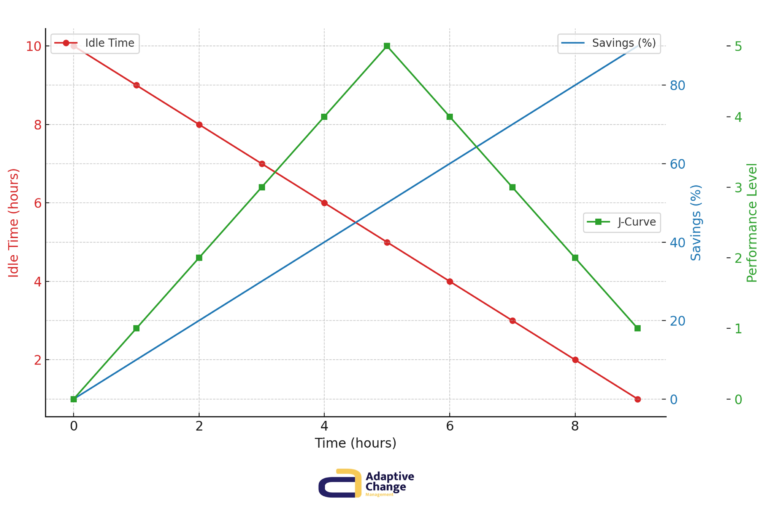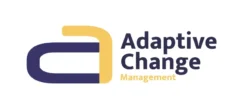Introduction
In a rapidly changing business environment, the ability to adapt quickly and effectively is crucial. Organizations must embrace a strategic approach to knowledge work, ensuring their systems are not only flexible but also maximising operational effectiveness. Central to our methodology is the Socioeconomic Kanban System, designed to minimise idle time and optimise workflow as businesses respond to these circumstances. This framework enhances key transitions within processes, enabling organisations to navigate the challenging J-curve—characterised by initial performance dips during change initiatives—more efficiently. By addressing these critical components, organizations can build resilience and drive successful transformation.
Understanding Idle Time and the J-Curve
Before delving into our approach, it’s essential to clarify two key concepts: idle time and the J-curve.
Idle time refers to periods when work is stalled due to inefficiencies or waiting for resources, decisions, or actions necessary to progress. This not only hampers productivity but can also lead to frustration among team members, affecting morale and engagement. Reducing idle time is crucial, as it enables teams to maintain momentum and focus, ultimately contributing to better performance outcomes.
The J-curve, on the other hand, is a graphical representation of performance over time during a change process. Initially, as changes are implemented, organizations often experience a decline in performance—representing the ‘downward’ part of the J. This dip can be attributed to the challenges associated with new processes, cultural adjustments, or learning curves. However, as the organization adjusts and becomes more adept at navigating these changes, performance begins to rise, leading to a more favorable outcome. Understanding the dynamics of the J-curve is vital for organizations as they plan and implement adaptive change strategies.
Our Approach: Scaling Knowledge Work for Adaptability
We empower organizations to enhance their adaptability by scaling knowledge work strategically. Our primary objective is to minimize idle time, particularly through the use of the Socioeconomic Kanban System, which provides a framework for visualizing and optimizing workflows. This system allows teams to identify bottlenecks and delays, streamlining processes to ensure work flows smoothly from one stage to the next.
Visualizing the workflow as a pipe system provides clarity on how work progresses and where potential delays may occur. Each connection in this pipe represents a critical juncture where artifacts—such as projects or tasks—transition from one state to another. For example, an artifact may move from “In Progress” to “Review,” and then to “Approved,” before finally being completed. Understanding this flow enables teams to pinpoint where idle time might arise, allowing them to take proactive steps to minimize delays.
By focusing on the distribution of frequency intervals within this workflow, organizations can gain insights into how different elements move through their processes. This analysis helps in understanding how often tasks are delayed and the reasons behind those delays. Our experience with clients reveals that many organizations struggle with defining their agile processes, often becoming overwhelmed by information overload and losing sight of their goals. By reducing complexity and ensuring that each team member understands their role in the workflow, organizations can foster a more streamlined and effective approach to adaptive change.
Tailoring Strategies to Meet Unique Needs
One of the core tenets of our methodology is recognizing that each organization has unique challenges and goals. By acknowledging the inherent variability in behaviors and responses among team members, we can tailor our strategies to fit the specific needs of different groups. This customization is essential for effective Adaptive Change Management.
Through the lens of our Socioeconomic Kanban System, we advocate for a focused approach that embraces the diversity within teams. For instance, some departments may thrive in a collaborative environment, while others may excel with a more autonomous structure. By understanding these dynamics, we help organizations create tailored strategies that align with their unique contexts, ultimately enhancing the overall effectiveness of their change initiatives.
This visualization offers a clear understanding of the benefits of reducing idle time in operations. By illustrating the relationship between idle time, savings, and the J-curve effect, it demonstrates how minimising idle time can result in greater savings and enhanced performance. This insight empowers managers to make informed decisions that optimise workflows and improve overall operational efficiency.
Enhancing Performance and Driving Innovation
Our approach not only minimizes idle time but also drives performance improvement across the organization. By streamlining workflows and ensuring that each stage of the process is optimized, we enable teams to respond more quickly to changes and capitalize on new opportunities for innovation. The enhanced flow system allows organizations to navigate the complexities of change with confidence, reducing the likelihood of setbacks and facilitating smoother transitions.
Moreover, by effectively managing the J-curve, organizations can mitigate the initial performance dips associated with change initiatives. By implementing proactive strategies and engaging team members throughout the process, businesses can foster a culture of adaptability and resilience.
Conclusion: Partnering for Success
In summary, our commitment to scaling knowledge work and minimizing idle time through the Socioeconomic Kanban System empowers organizations to achieve sustainable adaptability. By addressing the variability inherent in organizational workflows and optimizing key transitions, we enable businesses to traverse the J-curve more effectively, unlocking their full potential.
With our expertise in Adaptive Change Management, organizations can embrace change as an opportunity for growth rather than a source of disruption. As partners in this journey, we provide the insights and strategies necessary to ensure that your organization is well-equipped to navigate the complexities of today’s dynamic business environment. Together, we can shape a future where adaptability is not just a goal but a core competency, driving lasting success and innovation.
The graphs illustrate the relationship between idle time, savings, and the J-curve effect.
- Idle Time (Red Line): This line shows how idle time decreases as time progresses.
- Savings (Blue Line): As idle time reduces, savings increase, demonstrating a direct correlation.
- J-Curve (Green Line): This line represents the J-curve effect, where performance dips initially but then rises, reflecting the potential benefits of reducing idle time and optimizing workflows.

Fill out the form below, and we will respond within 48 hours.
Contact Us
We Shape The Future!
valuable. adaptive. innovative.
Our path of cooperation: Building trust, fostering relationships, and delivering value.
Get In Touch
- +381 65 6251 806
- +43 3322 43215
- +43 3322 43215
- [email protected]
Hours
- Mon-Fri 9:00AM - 5:00PM
- Sat 10:00AM - 2:00PM
